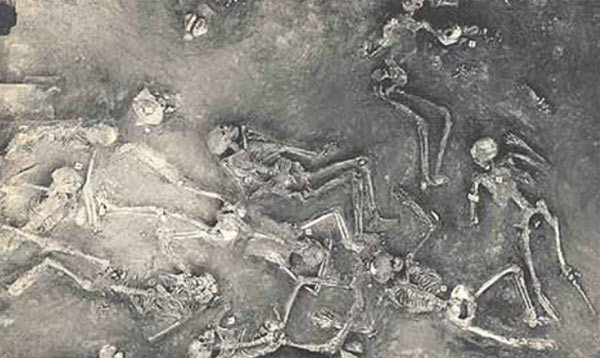To: fieldmarshaldj; Raycpa; Cronos; StayAt HomeMother; Ernest_at_the_Beach; 1ofmanyfree; 21twelve; ...
What were walls for?
Raycpa! We have a winner! Perhaps they didn't innovate in the direction of siege warfare -- not unlikely that the sizes of the cities played a factor. Given the architectural homogeneity, it isn't unlikely that the cities were in a continual state of remodeling, such that we're seeing only the last and very recent phase, all other traces gone.
It's also worth mentioning that the Indus Valley civilization a.k.a. Harappan civilization was only rediscovered in 1921. At first regarded as the wellspring of India, it is apparent from their surviving arts that they didn't know the horse, which is ubiquitous in all early Indian literature. Also, the still-undeciphered writing system appears to conceal and preserve an agglutinative language, a category that includes Dravidian, but not Indo-European languages. The last period of Harappan civ saw a population shift to the hinterlands -- apparently as the quarterly seasonal shift (wet-dry-wet-dry) became more severe, at least one of the tributaries of the Indus dried up, and the local diet shifted from wheat and barley to lower-yield millet and rice. A shift in what is eaten is reasonably deduced to indicate a cultural and ethnic transformation. Thanks fieldmarshaldj.

48 posted on
04/10/2018 2:27:07 PM PDT by
SunkenCiv
(www.tapatalk.com/groups/godsgravesglyphs/, forum.darwincentral.org, www.gopbriefingroom.com)
To: SunkenCiv
The Mohendaro Massacre  In a room with a public well in one area of the city were found the skeletons of two individuals who appeared desperately to have been using their last scraps of energy to crawl up the stair leading from the room to the street; the tumbled remains of two others lay nearby. Elsewhere in the area the ‘strangely contorted’ and incomplete remains of nine individuals were found, possibly thrown into a rough pit. In a lane between two houses in another area, another six skeletons were loosely covered with earth.
In a room with a public well in one area of the city were found the skeletons of two individuals who appeared desperately to have been using their last scraps of energy to crawl up the stair leading from the room to the street; the tumbled remains of two others lay nearby. Elsewhere in the area the ‘strangely contorted’ and incomplete remains of nine individuals were found, possibly thrown into a rough pit. In a lane between two houses in another area, another six skeletons were loosely covered with earth.
57 posted on
04/10/2018 3:28:50 PM PDT by
Fred Nerks
(fair dinkum!)
FreeRepublic.com is powered by software copyright 2000-2008 John Robinson

